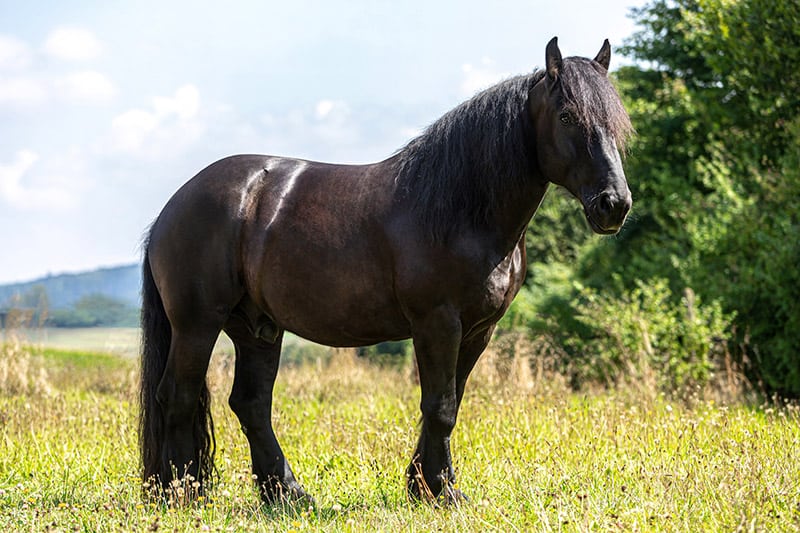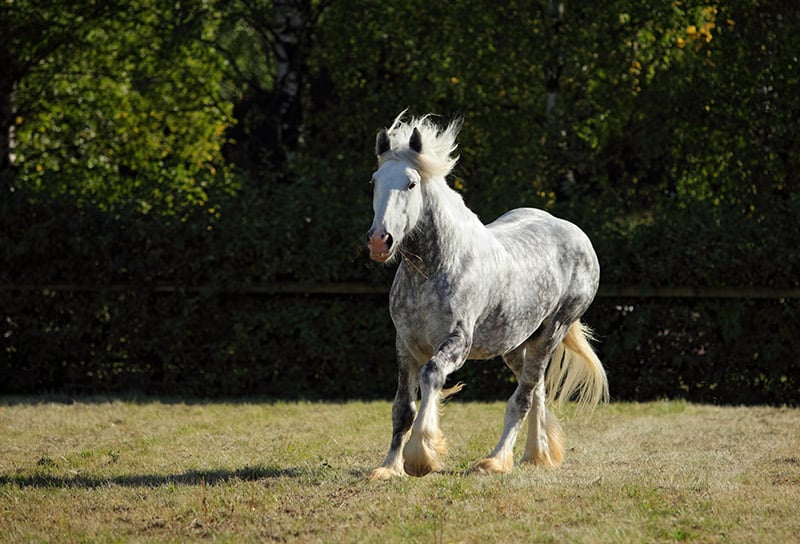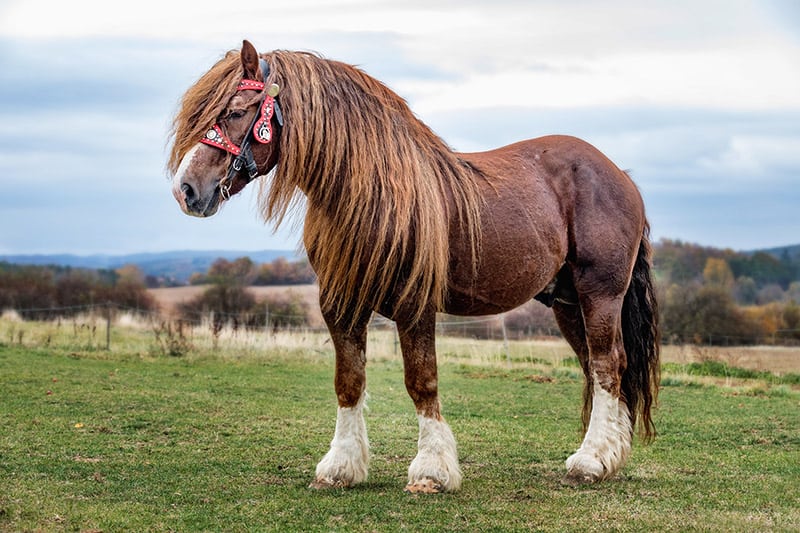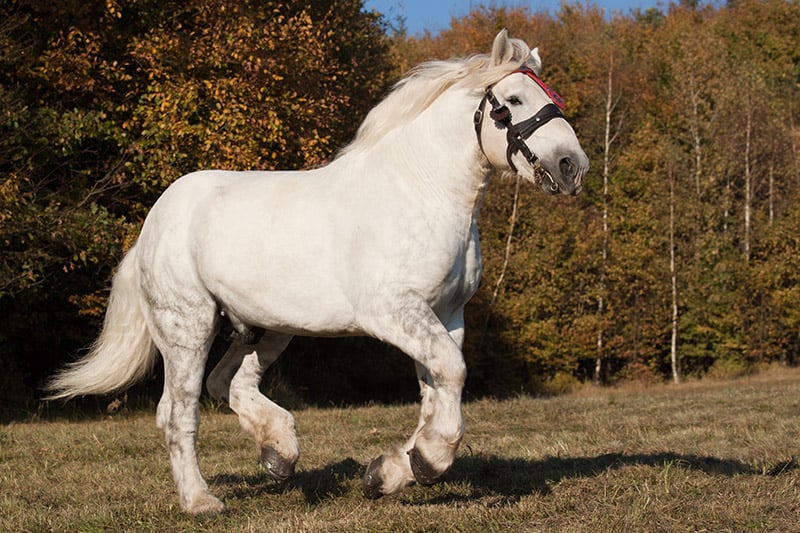Imported into the United States in the late 1880’s, the Percheron became America’s favorite horse!
The Percheron is large and heavy, yet elegant in its movement. It is a versatile and adaptable breed of draft horse of French descent. Known for its great strength and even temper, it was used widely for carriage driving and farm work. It also makes an excellent riding horse.
There are more Percherons in the United States than any other country. Here they enjoy a well earned popularity. The importation of almost 7,500 Percheron horses into the United States in the 1880’s led to the formation of the first livestock association. A group of Percheron breeders met in Chicago, Illinois in 1876, to create the Norman-Percheron Association and start the first stud book, though the name Norman was dropped the following year. In 1905 the breeders again met and formed the Percheron Society of America, which in 1934 became the present day association, the Percheron Horse Association of America.
Scientific Classification
| Kingdom: | Animalia |
| Phylum: | Chordata |
| Class: | Mammalia |
| Order: | Perissodactyla |
| Family: | Equidae |
| Genus: | Equus |
| Species: | caballus |
Horse Breeds
The Percheron is a Draft Horse or Heavy horse. The Draft horse is also known as the Draught Horse or Dray Horse. ‘Dray’ is a word derived from the Anglo-Saxon term for ‘to haul’ or ‘to draw’.
Draft horses are large and hardy, much heavier and broader than the light horses. The breeds in this horse class are referred to as cold blood breeds, in reference to their quiet and calm temperament. They are heavy in the body and strong legged. Many have have “feathers”, or long hair, covering their large hooves though this is not a characteristic of the Preacher.

Horse Backgrounds
Although the exact history of this breed is not known, the ancestors of the modern Percheron came from the horse friendly rolling green pastures of Le Perche, southwest of Paris. Horses here grew large and hardy as a consequence of the mild temperatures, lush pastures and good nutrition. In the early middle ages, Arab and Andalusian stallions were brought into the region in order to breed with the native mares.
In the time of the crusades, the horses from Le Perche were in great demand as war horses. By the 1700’s, as trade and commerce grew, they became popular as coach horses and farm horses. As the need grew for more driving horses, so did the necessity for heavy draft horses to move large loads from docks and railheads. There was a demand for a horse that could trot from 7 to 10 miles per hour and had the stamina to do it day in and day out.
In 1820, two grey Arab stallions were imported to breed exclusively to the horses from Le Perche. Still today, grey is the predominant color of the breed. The light colored grays and whites were preferred because of their visibility in the evening hours.
The Percheron quickly became America’s favorite horse. In the 1880’s almost 5,000 stallions and over 2,500 mares were imported to this country from France, mostly from Le Perche. In 1876, a group of Percheron breeders met in Chicago, Illinois, and formed the Norman-Percheron Association and the first stud book was started. This was the first purebred livestock association formed in the United States. The following year the name Norman was dropped. In 1905, Percheron breeders again met in Chicago and formed the Percheron Society of America which continued until 1934, when the present association, the Percheron Horse Association of America was formed as a non-profit organization.
Description
Percherons range in height from 15 to 19 hands high, most are between 16-2 and 17-3 hands high. They can weigh up to 2600 pounds with the average around 1900. The lower thighs are heavily muscled to give the horse enormous pulling power, making them economical movers with clean action and good balance. They are wide and deep through the chest with a large heart girth and well sprung ribs. The croup is level, tying into a large round hip. They lack the heavy feathering on the fetlocks seen in many other draft breeds.
Most Percherons are black or grey, but sorrels, bays, roans, and other colors are also seen. Many Percherons have white markings on the head and feet, but excessive white is undesirable.
The breed standard states “The Percheron head and neck are typical of the most attractive draft horse character. Good Percherons have a large and full prominent eye, a broad and full forehead, and straight face. His strong jaw and refined ears attractively set and carried with animation, suggests his Arabian ancestry. Stallions should have a ruggedness about the head and mares should have a feminine look.”

Horse Care and Feeding
Percherons are big eaters, easily eating 30 pounds of hay and over 5 pounds of grain and other supplements per day.
The Percheron is an easy keeper, and not particularly prone to health problems. Good grooming is essential, however, as their coats can get heavy in cold climates, and the hair around their ankles can attract bacteria in the soil, making them susceptible to “scratches” or pododermititis.
Because of their size, the Percheron needs a very large stall if kept inside. They do very well in pasture or on dry lot.
Horse Training and Activities
The Percheron has a very pleasing disposition. It is proud, alert, intelligent and willing. Tractable and an easy keeper, it is a versatile and adaptable breed of draft horse which was used widely for carriage driving and farm work. It is known for its great strength and even temper, making horse training for this breed suitable to a variety of disciplines. It makes an excellent riding horse.
Percherons are highly versatile animals. They are adaptable to most situations and types of work. They perform well under saddle, and many have been known to make successful hunters or jumpers. They are often crossed with lighter breeds to make an excellent and competitive sporthorse. Where they excel, however, is in driving. They have the strength to pull heavy loads and the graceful style to pull a fine carriage. They are still used regularly in small logging operations.
The Percheron Horse Association website states “The Percheron is very handy in saving the young trees in smaller wood lot operations as they do not need a wide road everywhere they work. They can get on and work ground where even the most modern tractors fail. Their independent four wheel drive conquers mud and snow to the shame of all man made machines.”
Common Health Problems
“Scratches” or pododermititis are more prevalent in horses that are subjected to wet muddy conditions for extended periods. Horses with white feet seem also to be more susceptible to scratches.

Availability
Percheron’s range greatly in price, depending on their training and bloodlines. There are over 290,000 Percherons registered with the Percheron Horse Association of America and they can direct you on where to find Percherons for sale in your area. .
Featured Image Credit: Vera Zinkova, Shutterstock
